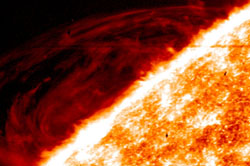 |
IRIS' First Glimpses of the Sun 12.09.13 – The fine detail in images of prominences in the sun's atmosphere from NASA's Interface Region Imaging Spectrometer – such as the red swirls shown here – are challenging the way scientists understand such events. + web view |
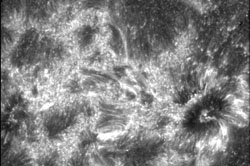 |
IRIS Opens Its Eye to the Sun 07.25.13 – Still image from the first IRIS movie, 21 hours after opening the telescope door on July 17, 2013. + web view | + associated news |
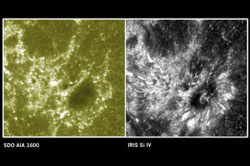 |
Comparison of Resolution Between SDO and IRIS 07.25.13 – This image compares the Solar Dynamics Observatory (SDO) Atmospheric Imaging Assembly (AIA) at 1600 Angstroms (on left) to the IRIS' Si IV (on right). + web view | + associated news |
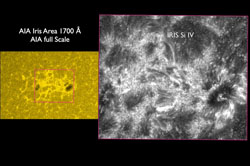 |
Comparing Resolution of SDO and IRIS 07.25.13 – On Left: The Solar Dynamics Observatory's full scale close-up of a solar active region in 1700 wavelength. On Right: The Interface Region Imaging Spectrograph (IRIS) full scale close-up of the same solar active region, illustrating its increased resolution. + web view |
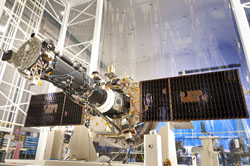 |
Completed IRIS Spacecraft in Clean Room 07.25.13 – This is a photo of the complete IRIS observatory with the solar arrays deployed. This is taken in a large clean tent at Lockheed Martin prior to vibration testing and prior to installation of the flight MLI blankets. The solar arrays have just been deployed using flight commands. + web view |
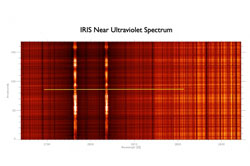 |
IRIS Spectra Data 07.25.13 – IRIS Near Ultraviolet Spectrum containing the Mg II h and Mg II k spectral lines formed by single ionized Magnesium atoms in the solar chromosphere (bright vertical features), the region between the solar surface and the sun's outer atmosphere. The horizontal axis shows wavelength, with the vertical axis showing the spatial direction. The vertical black lines are spectral lines formed on the Sun's surface. These spectra are used to determine velocities and temperatures of the emitting gas for a range of heights from the surface of the Sun to several thousand kilometer above the Sun's surface. The horizontal yellow line shows the cut that is used to create the movie in the following image. + web view |
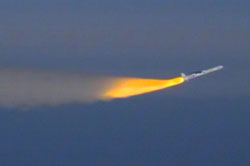 |
IRIS Launch – Pegasus Ignites 07.01.13 – The Pegasus rocket carrying the Interface Region Imaging Spectrograph (IRIS) satellite ignites its engine. + web view | + associated news |
 |
Aircraft Carrying IRIS Solar Observatory Takes Off 06.28.13 – An Orbital Sciences L-1011 carrier aircraft takes off from Vandenberg Air Force Base, Calif., on a mission to launch NASA's IRIS spacecraft into low-Earth orbit. IRIS, short for Interface Region Imaging Spectrograph, was launched on June 27, 2013 aboard an Orbital Sciences Pegasus XL rocket released from the L-1011. IRIS is a NASA Small Explorer Mission to observe how solar material moves, gathers energy and heats up as it travels through a little-understood region in the sun's lower atmosphere. This interface region between the sun's photosphere and corona powers its dynamic million-degree atmosphere and drives the solar wind. + web view |
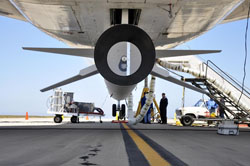 |
IRIS Launch Set for Thursday 06.26.13 – Technicians and engineers at Vandenberg Air Force Base in California mate the Pegasus XL rocket with the Interface Region Imaging Spectrograph, or IRIS, solar observatory to the Orbital Sciences L-1011 carrier aircraft. The launch of NASA's IRIS mission has been delayed one day to 10:27 p.m. EDT on Thursday, June 27. Live NASA Television launch coverage begins at 9 p.m. IRIS will open a new window of discovery by tracing the flow of energy and plasma through the chromospheres and transition region into the sun's corona using spectrometry and imaging. The IRIS mission will observe how solar material moves, gathers energy and heats up as it travels through a largely unexplored region of the solar atmosphere. The interface region, located between the sun's visible surface and upper atmosphere, is where most of the sun's ultraviolet emission is generated. These emissions impact the near-Earth space environment and Earth's climate. + web view |
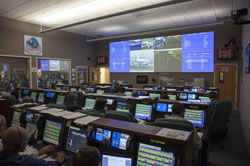 |
Preparing for Launch 06.25.13 – Inside the Launch Vehicle Data Center at Vandenberg Air Force Base in California, mission managers participate in a pre-launch dress rehearsal for NASA's Interface Region Imaging Spectrograph, or IRIS, solar observatory. + web view |
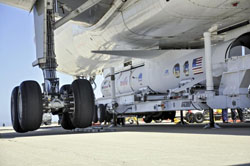 |
Aircraft and Rocket Joined 06.21.13 – Technicians and engineers at Vandenberg Air Force Base in California mate the Pegasus XL rocket with the Interface Region Imaging Spectrograph, or IRIS, solar observatory to the Orbital Sciences L-1011 carrier aircraft. + web view |
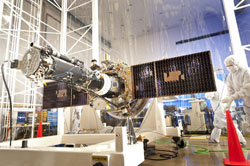 |
IRIS Preps for Launch 06.20.13 – The fully integrated spacecraft and science instrument for NASA's Interface Region Imaging Spectrograph (IRIS) mission is seen in a clean room at the Lockheed Martin Space Systems Sunnyvale, Calif. facility. The solar arrays are deployed in the configuration they will assume when in orbit. IRIS is scheduled to launch on June 26, 2013. Understanding the interface between the photosphere and corona remains a fundamental challenge in solar and heliospheric science. The IRIS mission opens a window of discovery into this crucial region by tracing the flow of energy and plasma through the chromosphere and transition region into the corona using spectrometry and imaging. IRIS is designed to provide significant new information to increase our understanding of energy transport into the corona and solar wind and provide an archetype for all stellar atmospheres. The unique instrument capabilities, coupled with state of the art 3-D modeling, will fill a large gap in our knowledge of this dynamic region of the solar atmosphere. The mission will extend the scientific output of existing heliophysics spacecraft that follow the effects of energy release processes from the sun to Earth. + web view |
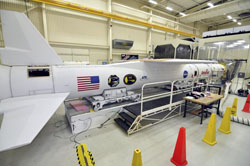 |
Pegasus Rocket 06.13.13 – The Orbital Sciences Pegasus XL rocket that will lift NASA's IRIS solar observatory into orbit is seen in a hangar at Vandenberg Air Force Base. IRIS, short for Interface Region Imaging Spectrograph, is being prepared for launch from Vandenberg. + web view |
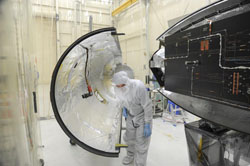 |
Preparing NASA's Next Solar Satellite for Launch 06.12.13 – Orbital Sciences team members move the second half of the payload fairing before it is placed over NASA's IRIS (Interface Region Imaging Spectrograph) spacecraft. The fairing connects to the nose of the Orbital Sciences Pegasus XL rocket that will lift the solar observatory into orbit. The work is taking place in a hangar at Vandenberg Air Force Base, where IRIS is being prepared for launch on a Pegasus XL rocket. Scheduled for launch from Vandenberg on June 26, 2013, IRIS will open a new window of discovery by tracing the flow of energy and plasma through the chromospheres and transition region into the sun's corona using spectrometry and imaging. IRIS fills a crucial gap in our ability to advance studies of the sun-to-Earth connection by tracing the flow of energy and plasma through the foundation of the corona and the region around the sun known as the heliosphere. + web view |
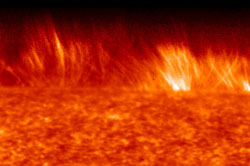 |
Hinode's View of Interface Region 05.29.13 – This image from JAXA's Hinode mission shows the lower regions of the sun's atmosphere, the interface region, which a new mission called the Interface Region Imaging Spectrograph, or IRIS, will study in exquisite detail. Where previous missions have been able to image material at only a few predetermined temperatures in this region, IRIS will observe a wide range of temperatures from 5000 Kelvins to 65,000 Kelvins (and up to 10 million Kelvins during solar flares). Its images will resolve structures down to 150 miles across. + web view | + associated news |
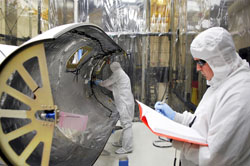 |
Preparing Solar Satellite for Launch 04.18.13 – VANDENBERG AFB, Calif. – Technicians work on the payload fairing that will protect NASA's Interface Region Imaging Spectrograph (IRIS) spacecraft during launch aboard an Orbital Sciences Pegasus XL rocket. Launch is currently scheduled no earlier than May 28, 2013. The IRIS satellite will improve our understanding of how heat and energy move through the deepest levels of the sun's atmosphere, thereby increasing our ability to forecast space weather. On launch day, deployment of the Pegasus from Orbital's L-1011 carrier aircraft will occur at a location over the Pacific Ocean about 100 miles northwest of Vandenberg off the central coast of California south of Big Sur. + web view |
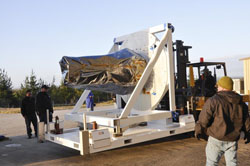 |
IRIS Arrives at Vandenberg AFB 04.17.13 – Workers unload NASA's IRIS spacecraft from a truck at the processing facility at Vandenberg where the spacecraft will be readied for launch aboard an Orbital Sciences Pegasus XL rocket. IRIS is short for Interface Region Imaging Spectrograph and the spacecraft's mission will improve our understanding of how heat and energy move through the deepest levels of the sun's atmosphere, thereby increasing our ability to forecast space weather. + web view | + associated news |
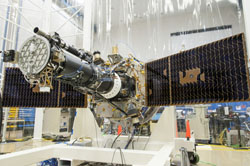 |
Testing Solar Panel Functionality 02.11.13 – NASA's Interface Region Imaging Spectrograph (IRIS) with solar panels, seen here in the clean room at the Lockheed Martin Advanced Technology Center in Palo Alto, where it was designed and built. + web view |
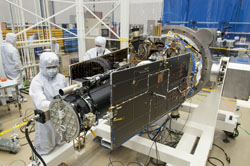 |
Integration of Solar Panels 02.11.13 – Engineers secure the solar panels to the telescope for NASA's Interface Region Imaging Spectrograph (IRIS), seen here in the clean room at the Lockheed Martin Advanced Technology Center in Palo Alto, where it was designed and built. + web view |
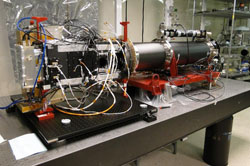 |
Ready for Integration 02.11.13 – Sitting on a work bench, the main telescope and back-end electronics are ready for integration with the deck of NASA's Interface Region Imaging Spectrograph (IRIS). + web view |
 |
Mating Telescope and Electronics 02.11.13 – Sitting on a work bench, the main telescope is ready to be mated to the back-end electronics of NASA's Interface Region Imaging Spectrograph (IRIS). + web view |
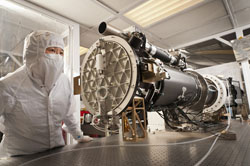 |
IRIS Integration Review 01.18.13 – Lockheed Martin Space Systems engineer Cathy Chou, integration and test lead for NASA's Interface Region Imaging Spectrograph (IRIS) observatory, inspects the IRIS solar telescope in a clean room at the company's Advanced Technology Center in Palo Alto, Calif. + web view | + associated news |
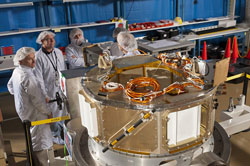 |
IRIS Spacecraft Bus in Cleanroom 11.11.12 – The spacecraft bus structure for NASA's Interface Region Imaging Spectrograph (IRIS) mission, is seen in a cleanroom in a Lockheed Martin Space Systems Company cleanroom in Sunnyvale, Calif. The bus is currently undergoing integration with the IRIS telescope. + web view |
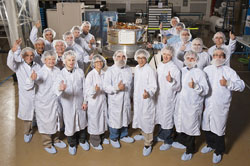 |
IRIS Spacecraft Team 10.11.12 – The Lockheed Martin Space Systems Company spacecraft team in Sunnyvale, Calif. is seen posing in front of the completed spacecraft bus for NASA's Interface Region Imaging Spectrograph (IRIS) mission. The bus is currently undergoing integration with the IRIS telescope. + web view |
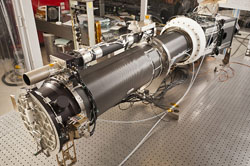 |
IRIS Instrument Complete 10.11.12 – The telescope for NASA's Interface Region Imaging Spectrograph (IRIS) is seen on a bench at the Lockheed Martin Advanced Technology Center in Palo Alto, where it was designed and built. The telescope is currently undergoing integration with the IRIS spacecraft bus. The IRIS instrument is a multi-channel imaging spectrograph with a 20 cm (8ft) UV telescope. + web view |
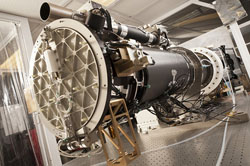 |
IRIS Instrument Ready for Integration 10.11.12 – The telescope for NASA's Interface Region Imaging Spectrograph (IRIS) is seen on a bench at the Lockheed Martin Advanced Technology Center in Palo Alto, where it was designed and built. The telescope is currently undergoing integration with the IRIS spacecraft bus. The IRIS instrument is a multi-channel imaging spectrograph with a 20 cm (8ft) UV telescope. + web view |
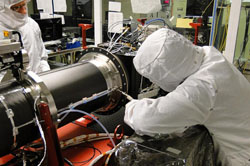 |
Working On IRIS Spectrometer An engineer works on the spectrometer instrument for IRIS. + web view |
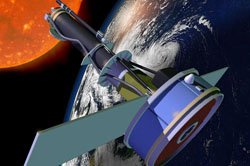 |
Concept IRIS in Orbit Artist's concept of the Interface Region Imaging Spectrograph (IRIS) satellite in orbit. + web view |
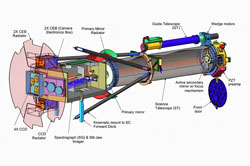 |
Cutaway Diagram of IRIS This cutaway diagram shows the IRIS spacecraft components, without solar panels for clarity. + web view |
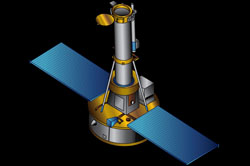 |
IRIS – Black Background An artist rendition of the Interface Region Imaging Spectrograph (IRIS), a NASA Small Explorer Mission to observe how solar material moves, gathers energy, and heats up as it travels through a little-understood region in the sun's lower atmosphere. + web view |
 |
IRIS – White Background An artist rendition of the Interface Region Imaging Spectrograph (IRIS), a NASA Small Explorer Mission to observe how solar material moves, gathers energy, and heats up as it travels through a little-understood region in the sun's lower atmosphere. + web view |
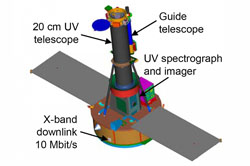 |
IRIS Components An artist rendition of the Interface Region Imaging Spectrograph (IRIS), with major components labeled. IRIS is a NASA Small Explorer Mission to observe how solar material moves, gathers energy, and heats up as it travels through a little-understood region in the sun's lower atmosphere. + web view |